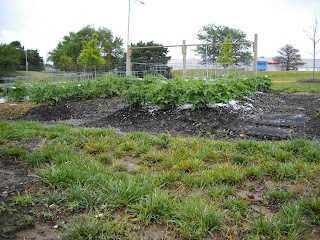Just another example of our raised beds that create a loose soil that roots easily grow in.
Thursday, June 28, 2012
The Bella Anna hydrangea seen here at the foot of each bed may not look like much now. But when they've rooted and had a year or two to grow they should produce excellent flowers for the Floral Shop. We'll also be adding Endless Summer Hydrangea to this same bed. The main reason these plants were selected for this location is that it retains quite a bit of moisture. And these plants will love hanging out here in the rich, moist soil.
Friday, June 15, 2012
Golden Ruby Barberry
One of our more unique plants in the garden is "Golden Ruby" Barberry. It's variegated leaf margins give this plant a brighter color and could provide interest in any garden. A few notes from the grower:
This eye-catching new Barberry, hardy to Zone 4, stands out with its unique color transformation throughout the season. Spring foliage emerges a striking fluorescent orange, with leaves maturing to a burgundy maroon with a gold ring around the outer leaf margin in summer. Fall color is a flame orange to brick red. This bold color combination stands out in
the garden against more subdued landscape plantings.
Golden Ruby™ is very slow growing reaching approximately 15” high and 24” wide. Unlike many other barberry varieties, fruit set is sparse. It will perform best planted in full sun in well drained soil.
Double KnockOut Roses
As with the previous post on marigolds, you'll find these beautiful Double Knock Out Roses in the garden. These newer shrub rose type plants bloom almost all season and add amazingly vivid and bright color to the garden. Here are a few notes from the Knock Out Rose website:
Knock Out® Roses are easy to grow and do not require special care. They are the most disease resistant roses on the market today! They have stunning flower power with a generous bloom cycle (about every 5-6 weeks) that will continue until the first hard frost. All seven members in The Knock Out® Family of Roses are self-cleaning so there is no need to deadhead.
The Knock Out® Family of Roses are winter hardy to USDA Zone 5 and heat tolerant throughout the entire U.S. They thrive in almost every area of the country. In the coldest regions, they will need winter protection (check with your local garden center to see what method is best for your area).
If unpruned, The Knock Out® Family of Roses can easily grow to be more than 3-4' wide x 3-4' tall. A once a year cut (to about 12-18" above the ground) in early spring (after the last hard frost) is also recommended for maximum performance.
The Knock Out® Family of Roses can fit any landscape. Plant them individually among shrubs, annuals and perennials in mixed beds and borders. Plant them in large groups to create a colorful hedge. Plant them along a foundation to provide a bright border.
Marigolds and Veggie Gardens
Marigolds come in a variety of bright yellows and oranges and are pretty easy to grow. They should be planted in areas where they will receive constant sunlight. To keep them blooming simply deadhead old blooms by pinching or pruning the spent flowers back to the the stem or the next set of leaves and blooms. Here are a few quick notes about the benefits of marigolds in your vegetable garden:
Annual Marigolds can be used anywhere to deter Mexican bean beetles, squash bugs, thrips, tomato hornworms, and whiteflies. They are also known to repel harmful root knot nematodes (soil dwelling microscopic white worms) that attack tomatoes, potatoes, roses, and strawberries. The root of the Marigold produces a chemical that kills nematodes as they enter the soil. If a whole area is infested, at the end of the season, turn the Marigolds under so the roots will decay in the soil. You can safely plant there again the following spring.
Stonybrook Garden 2012
The 2012 edition of the Hy-Vee Garden at Stonybrook has brought significant changes to the soil and the layout of the garden. Last fall Stonybrook Hy-Vee Store Director Ginny Ward approved the purchase of 150 cubic yards of Oma-Gro compost. Over a three day period in October the compost was delivered, moved into the garden beds and tilled into the soil to rest for the winter. Oma-Gro compost can be hot when freshly delivered as ours was and needed time to cool down before planting this spring. Another special thank you to Matt Novak and his team at Diamond Cut Lawns for donating the front-end loader we needed to till the soil and move the compost. Look for more postings today and in the coming months and don't forget to follow the garden. Thank you!
Subscribe to:
Posts (Atom)

















